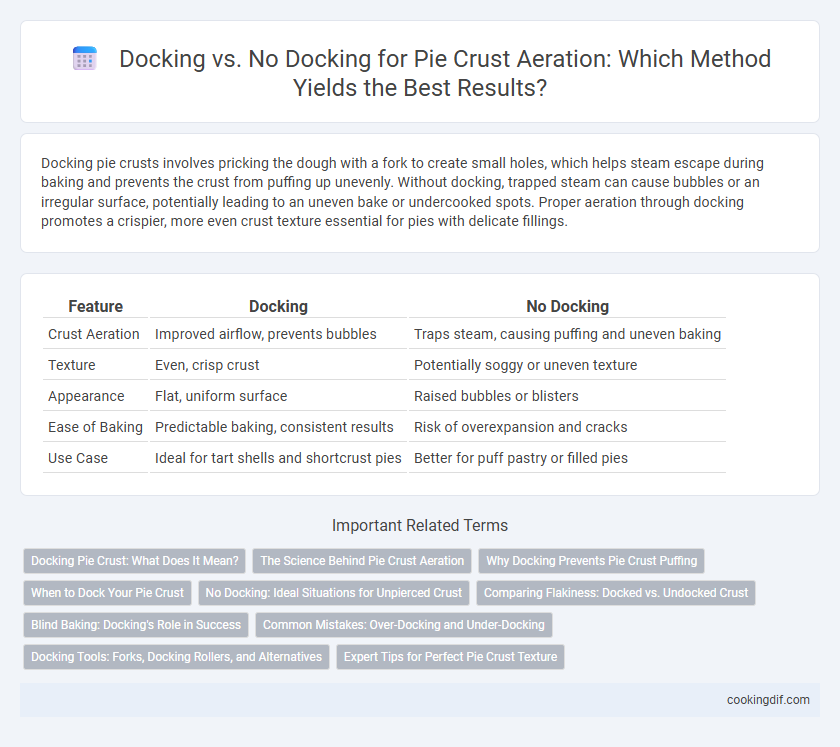Docking pie crusts involves pricking the dough with a fork to create small holes, which helps steam escape during baking and prevents the crust from puffing up unevenly. Without docking, trapped steam can cause bubbles or an irregular surface, potentially leading to an uneven bake or undercooked spots. Proper aeration through docking promotes a crispier, more even crust texture essential for pies with delicate fillings.
Table of Comparison
| Feature | Docking | No Docking |
|---|---|---|
| Crust Aeration | Improved airflow, prevents bubbles | Traps steam, causing puffing and uneven baking |
| Texture | Even, crisp crust | Potentially soggy or uneven texture |
| Appearance | Flat, uniform surface | Raised bubbles or blisters |
| Ease of Baking | Predictable baking, consistent results | Risk of overexpansion and cracks |
| Use Case | Ideal for tart shells and shortcrust pies | Better for puff pastry or filled pies |
Docking Pie Crust: What Does It Mean?
Docking a pie crust involves puncturing the dough with a fork or docking tool to allow steam to escape during baking, preventing air bubbles and uneven rising. This technique ensures a crisp, flat crust ideal for pies requiring blind baking before adding filling. Skipping docking can result in a puffy, uneven crust that may disrupt the pie's texture and presentation.
The Science Behind Pie Crust Aeration
Docking pie crusts involves creating small holes that allow steam to escape, preventing bubbles and uneven rising during baking by regulating moisture and pressure. Without docking, trapped steam causes pockets that disrupt the crust's structural integrity and create an uneven texture. Scientific studies show that controlled aeration from docking leads to a flakier, more uniform crust by balancing steam release and dough expansion.
Why Docking Prevents Pie Crust Puffing
Docking pie crust with a fork creates small holes that allow steam to escape during baking, preventing the crust from puffing up unevenly. This technique maintains an even surface ideal for fillings by reducing trapped air and excess moisture buildup. Without docking, steam causes the dough to rise, forming unwanted bubbles that can disrupt the texture and appearance of the pie crust.
When to Dock Your Pie Crust
Docking your pie crust is essential when baking unfilled or blind-baked crusts to prevent unwanted bubbling and ensure even aeration. Avoid docking filled pies as fruit juices and fillings provide natural steam release, maintaining crust integrity without excess moisture loss. Understanding when to dock supports optimal texture by balancing crust aeration with filling moisture content.
No Docking: Ideal Situations for Unpierced Crust
No docking is ideal for pie crusts that require a fully sealed bottom to contain custard or fruit fillings, preventing leaks and maintaining moisture. This technique is beneficial for single-crust pies like pumpkin or pecan, where aeration could cause filling seepage or crust shrinkage. Unpierced crusts bake with a tender, flaky texture, preserving the pie's structural integrity while delivering optimal taste and appearance.
Comparing Flakiness: Docked vs. Undocked Crust
Docking a pie crust creates small holes that allow steam to escape, resulting in a crispier, more even bake, but it can reduce flakiness by preventing the dough from rising and separating into delicate layers. An undocked crust traps steam, which encourages puffing and contributes to a flakier texture with distinct, tender layers. For maximum flakiness, many bakers prefer not to dock the crust, especially in recipes aiming for a light, airy pie base.
Blind Baking: Docking's Role in Success
Docking pie crust before blind baking prevents air bubbles by allowing steam to escape, ensuring an even, flat surface critical for fillings. Without docking, trapped steam causes uneven rising and puffing, compromising the crust's structure and texture. Proper docked crusts achieve a consistently crisp and sturdy base essential for successful blind baking outcomes.
Common Mistakes: Over-Docking and Under-Docking
Over-docking pie crust leads to excessive punctures, causing the dough to become too dry and prone to shrinking during baking. Under-docking traps steam, resulting in uneven aeration and bubbles or puffed areas on the crust surface. Properly aerated pie crust requires balanced docking to ensure even heat distribution and a crisp, flaky texture.
Docking Tools: Forks, Docking Rollers, and Alternatives
Docking tools such as forks, docking rollers, and alternative instruments create small perforations in pie crusts to promote airflow and prevent bubbling during baking. Forks allow precise, manual docking with easily controlled pressure, ensuring even aeration, while docking rollers enable rapid, uniform perforations, ideal for high-volume preparation. Alternatives, including specialized docking stamps and rolling pins with built-in prongs, offer varied textures and patterns to optimize crust aeration and maintain structural integrity.
Expert Tips for Perfect Pie Crust Texture
Docking pie crust creates small holes that allow steam to escape, preventing bubbles and ensuring even baking for a crisp, flaky texture favored by professionals. Expert bakers recommend docking when blind baking to maintain flatness and avoid crust puffiness, essential for custard or cream pies. For double-crust pies, skipping docking preserves moisture and tenderness, resulting in a soft, buttery finish that complements fruit fillings.
Docking vs no docking for pie crust aeration Infographic

 cookingdif.com
cookingdif.com